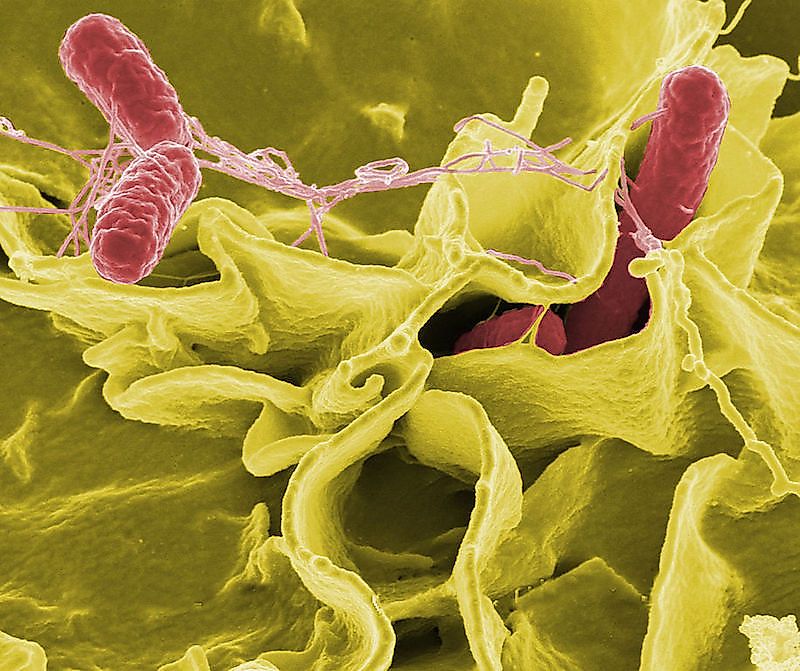The Worst Outbreaks Of Pathogen Induced Foodborne Illnesses In History

A foodborne illness is a result of having consumed contaminated food or drink. The contamination can occur due to a number of factors including bacteria, virus, parasite, chemical, or toxin. In layman terms, a foodborne illness is often called food poisoning. While treatment is available for most infections, people with weak immune systems, like children under five years old, people with immunodeficiency disorders, and senior citizens, are often unable to survive the illnesses. This article takes a look at some of the most common pathogens and the worst foodborne illnesses in history.
One of the most common pathogens is E.coli, a bacteria that causes severe diarrhea and cramping. In some people, this infection may result in kidney failure. Listeria, another bacteria, is one of the most dangerous pathogens and causes death in 20-30% of infected people. Commonly found in unpasteurized dairy products, a listeria infection can involve the brain, spinal cord, or bloodstream. The salmonella bacteria infects thousands of people annually; those with healthy immune systems are likely to survive without treatment although the symptoms include diarrhea, vomiting, cramps, and fever which can lead to dehydration. If the infection spreads to the bloodstream, the resulting illness is called typhoid fever.
Staphylococcus is a bacteria that is commonly found on the skin and in the surrounding environment. It produces a toxin that can infect the intestinal system and cause cramps, diarrhea, fever, and dehydration. Finally, the Hepatitis A virus can also contaminate food products resulting in stomach and intestinal infections. Sometimes this virus also moves into the liver causing jaundice, appetite loss, and nausea. It is found on food products that have been contaminated by fecal matter.
Worst Outbreaks in History
The worst foodborne disease outbreak in history, according to the number of deaths, happened in Germany in 2011. This incident was caused by the E. coli O104:H4 bacteria from fresh produce that was grown on an organic farm. The farm was shut down but not before 3,950 people were infected. This particular strain of the bacteria caused bloody diarrhea and a hemolytic-uremic syndrome which led to acute kidney failure. In total, 53 people died as a result of the outbreak.
In 1985, an outbreak of listeriosis hit California in the US. This event was caused by infected cheese that had not been properly pasteurized. It was believed to be the deadliest outbreak of the time, having infected 142 people. Approximately 65% of these individuals were pregnant women, and the listeriosis went on to infect their fetuses. Deaths numbered 52 and included 19 stillbirths.
The third most deadly foodborne illness outbreak occurred in 2011. This event was yet again a listeriosis strain that contaminated cantaloupe grown in Colorado in the US. The cantaloupe was shipped to 25 states and resulted in 147 cases. The average age of infected individuals was 78 years. Again, this outbreak infected pregnant women and caused at least one miscarriage. The death rate reached 30.
Below is a list of other serious outbreaks throughout history.
Preventing Foodborne Illness
Foodborne illness can be prevented although as food production grows and products travel longer distances to reach their destination, risk increases. Many factory-farmed animals carry the pathogens that lead to infection in their intestines. They either spread this through fecal matter or during slaughter when the meat becomes infected. Agriculture then becomes infected when irrigated with contaminated water.
These illnesses can be prevented during regular grocery shopping. Customers can search for produce that is kept separate from raw meat products. These foods should also be kept separate in grocery bags in the kitchen at home. Customers can also make sure that packaging is intact and clean. Cooking and handling foods at home are also important. Perishable foods should not be left between 40 and 140 degrees F for more than 2 hours and should be refrigerated as soon as possible.
The Worst Outbreaks Of Pathogen Induced Foodborne Illnesses In History
| Rank | Year | Event | Deaths |
|---|---|---|---|
| 1 | 2011 | 2011 Germany E. coli O104:H4 outbreak | 53 |
| 2 | 1985 | 1985 California listeriosis outbreak in cheese | 47 or 52 |
| 3 | 2011 | 2011 United States listeriosis outbreak in cantaloupes | 30 |
| 4 | 2008 | 2008 Canadian listeriosis outbreak in cold cuts | 22 |
| 5 | 1996 | 1996 Wishaw E. coli outbreak | 20 |
| 6 | 2014 | 2013–2014 Danish listeriosis outbreak, | 15 |
| 7 | 1998 | 1998 United States listeriosis outbreak in cold cuts | 18 or 21 |
| 8 | 1985 | 1985 United States salmonellosis outbreak in milk | 9 |
| 9 | 2008 | 2008 United States salmonellosis outbreak in peanuts | 9 |
| 10 | 2002 | 2002 United States listeriosis outbreak in poultry | 8 |
| 11 | 1993 | 1993 Jack in the Box E. coli outbreak | 4 |











